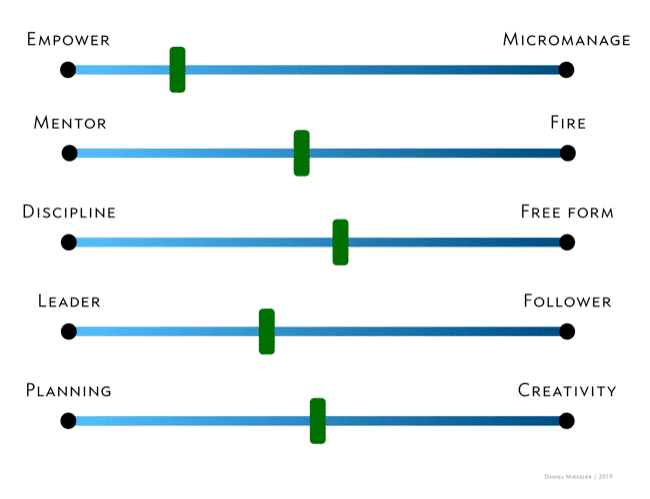Summary: The Dichotomy of Leadership
My book summaries > are designed as captures for what I’ve read, and aren’t necessarily great standalone resources for those who have not read the book.Their purpose is to ensure that I capture what I learn from any given text, so as to avoid realizing years later that I have no idea what it was about or how I benefited from it.
My One-Sentence Summary
The best leaders manage the balance between the extremes of a few core attributes: confidence and humility, discipline vs. creativity, mentoring vs. firing, training hard vs. smart, leading and following, and empowering vs. micromanaging.
Content Extraction

A few of the major leadership attribute spectrums
Empower others, but be willing to step in with micromanagement temporarily if things get out of hand
Don’t be so dominating and intimidating that your leaders can’t step up and lead themselves
Discipline is great, but too much leads to a lack of creativity
Too much creativity and not enough discipline leads to sloppiness and mistakes
All quotes here are from the book itself unless otherwise indicated.
"The three components of great training are realism, fundamentals, and repetition."
Plan enough to provide comfort when things go wrong, but not so much that you limit creativity
Train in a very realistic way, but don’t overtrain in a way that removes their motivation or overwhelms them with information
Be confident and willing to push through your strategy with others, but also remain humble about the ability for the world to serve you lessons, and about your team’s ability to teach you things you don’t know
Ensure that when you’ve gone too far in one direction in these attributes, that when you correct you don’t overcorrect by going too far in the other direction
Takeaways
The whole book is about constantly adjusting the balances between extremes across multiple leadership attributes.
The key is to be aware of what those attributes are, what their extremes are, and what the downsides are of going too much in each direction.
Great leaders, in other words, are those who can maintain optimal levels of each attribute according to what’s needed to best accomplish the mission in the short and long-term.
You can find my other book summaries here >.
Notes
There is a previous book by the same two guys, called Extreme Ownership, and while it was good, it did emphasize the extremes of each point that was made. This book corrects that by focusing everything on the balances that have to be constantly adjusted for the situation. This is basically the better version of the first book, but you can still benefit from the first one as well.